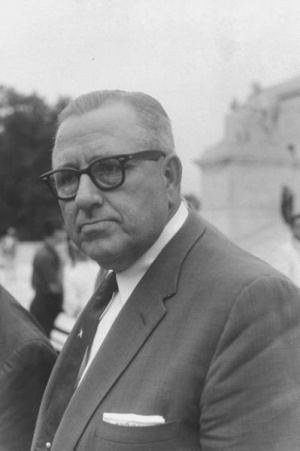Difference between revisions of "Virgil Blossom"
From FranaWiki
| (One intermediate revision by the same user not shown) | |||
| Line 1: | Line 1: | ||
| + | [[Image:Blossom.jpg|thumb|Superintendent Blossom in August 1958. Photo by LIFE photographer Ed Clark.]] | ||
'''Virgil Blossom''' was a 1950s-era superintendent who advocated a gradual desegregation plan for the Little Rock School District. He noted that "uncontrolled integration would lower the quality of schools." Blossom was criticized by [[Daisy Bates]] and [[L.C. Bates]] for placing schools and personnel in a way that preserved the status quo of segregated facilities and staff. | '''Virgil Blossom''' was a 1950s-era superintendent who advocated a gradual desegregation plan for the Little Rock School District. He noted that "uncontrolled integration would lower the quality of schools." Blossom was criticized by [[Daisy Bates]] and [[L.C. Bates]] for placing schools and personnel in a way that preserved the status quo of segregated facilities and staff. | ||
| − | In February 1956 thirty-three African-American students filed suit against the school district, which refused to admit them to four white high schools, in the case of ''Aaron v. Cooper.'' The case was dismissed by federal judge John E. Miller, who found Blossom's plan for gradualism acceptable. | + | In February 1956 thirty-three African-American students filed suit against the school district, which refused to admit them to four white high schools, in the case of ''[[Aaron v. Cooper]].'' The case was dismissed by federal judge John E. Miller, who found Blossom's plan for gradualism acceptable. |
==References== | ==References== | ||
==External links== | ==External links== | ||
Latest revision as of 22:33, 20 November 2008
Virgil Blossom was a 1950s-era superintendent who advocated a gradual desegregation plan for the Little Rock School District. He noted that "uncontrolled integration would lower the quality of schools." Blossom was criticized by Daisy Bates and L.C. Bates for placing schools and personnel in a way that preserved the status quo of segregated facilities and staff.
In February 1956 thirty-three African-American students filed suit against the school district, which refused to admit them to four white high schools, in the case of Aaron v. Cooper. The case was dismissed by federal judge John E. Miller, who found Blossom's plan for gradualism acceptable.
